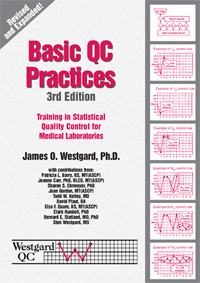Basic QC Practices
Pre-Analytical and Post-Analytical QC
For more than a decade, the scientific literature has stressed the preeminence of pre-analytical error. Often these papers play a zero-sum game, emphasizing pre- and post-analytical quality while diminishing the importance of analytical quality. In this lesson, sources of errors for the pre-analytic and post-analytic phases of the Total Testing Process are discussed, along with possible solutions. Finally, the occurrence of these errors are rated on a Sigma-scale, to put pre-analytical problems into context with analytical performance. (Preview)
Quality Control "Outside the box": Pre-Analytic and Post-Analytic Quality Control Strategies
Sten Westgard, MS
- Errors outside the box
- Quality Management outside the box
- Well-defined procedures. Training. Standardization
- Automation
- Pre-Analytical Workstation Solutions
- Re-engineering. Redesign. Lean
- A note about post-analytic errors
- How important are pre-analytic and post-analytic errors, anyway?
- What's the Point?
“Happy families are all alike. Every unhappy family is unhappy in its own way.”
Leo Tolstoy, Anna Karenina
Great Russian novels have their uses. In laboratories, analytical errors are mostly all alike: every method has some amount of analytical error, in the form of systematic and random error. As noted in previous chapters, there are reliable ways to monitor, control, and improve the analytical process. (Believe it or not, this is the Happy part)
But when we discuss pre-analytical error, each laboratory has pre-analytical errors in their own way (This is the Unhappy part). Of course, the many differences in pre-analytical error are to be expected.
While the analytical process is essentially the same in each laboratory (the instruments and methods are designed to perform the same process), the path that the patient specimen takes to reach that instrument is unique to each healthcare setting. And often the return of the test result also has its own unique path and ends up on a one-of-a-kind report.
Accordingly, since the problems tend to be unique, the solutions must often be customized. This makes it more challenging to describe guidelines for pre-analytical and post-analytical problems.
Errors Outside the Box
The definition of what constitutes a pre-analytical and post-analytical error can also be confusing. Recently, the literature has defined not only pre-analytical errors, but pre-pre-, pre-, post-, and postpost-analytical errors. Analytical errors are often narrowly defined as errors “in the box,” which occur only within the laboratory and sometimes only during the actual analysis step when the specimen
is inside the instrument. Everything else is outside the box.
It may be more helpful to describe different steps in the Total Testing Process and identify when and what kind of possible errors may occur. This is just a brief overview – there are entire books
devoted to different parts of the total testing process (e.g., see the trilogy on the Total Testing Process from AACC Press [1-3]). Also, Chapter 5 discussed the CLSI “source of errors matrix” document
that identifies many failure-modes that contribute to laboratory errors [4]. The tables below provide another perspective from a recent discussion of “error tracking” in a medical laboratory [5]:
| Types of Errors encountered in Laboratory Testing | |
| Phase | Possible Errors |
| Ordering | Sample without order Duplicate order Incorrect test Not readable Incorrect time / date Incorrect priority Typing error |
| Collection | Forgotten Failed Incorrect tube Lost tube Incorrect volume Incorrect temperature Incorrect treatment Patient state not appropriate (example: patient not fasting) Incorrect time / date Incorrect priority Tube missing Patient missing |
| Identification |
(this type of error can occur at any Insufficient clinical information More details in the book... |
Source: Pal Bela Szecsi, Lars Odum, Error Tracking in a clinical biochemistry laboratory, Clin Chem Lab Med 2009;47(10):1253-1257.
 We invite you to read the entire lesson.
We invite you to read the entire lesson.
To read a complete version of this article, we invite you to purchase the Basic QC Practices manual, Third edition.
